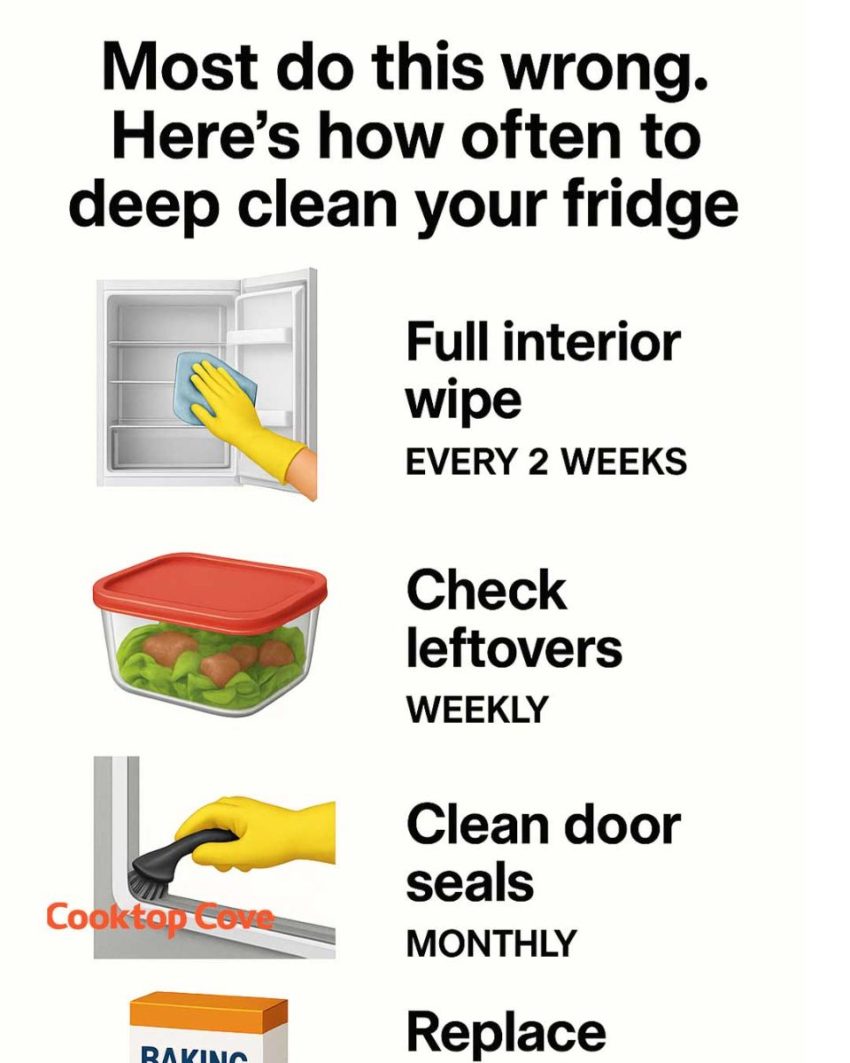ADVERTISEMENT
1. Full Interior Wipe – Every 2 Weeks
A full interior wipe of your fridge should be done every two weeks to prevent the buildup of spills and crumbs. Start by removing all the food items and placing them in a cooler to keep them fresh. Use a mixture of warm water and mild dish soap to wipe down all surfaces, including shelves, walls, and the ceiling of the fridge. Pay special attention to the corners and crevices where grime tends to accumulate.
For stubborn stains, a paste made from baking soda and water can be used as a gentle abrasive. Rinse with a clean, damp cloth and dry thoroughly with a towel before returning the food to the fridge. This regular cleaning routine will help prevent odors and keep your fridge looking and smelling fresh.
2. Check Leftovers – Weekly
Leftovers can quickly become a source of unpleasant odors and bacteria if not managed properly. Set aside time each week to check the leftovers in your fridge. Discard any items that are more than a few days old or show signs of spoilage, such as mold or an off smell.
To help keep track of how long leftovers have been in the fridge, consider labeling containers with the date they were stored. This simple practice can prevent food waste and ensure that your fridge remains a safe place for food storage.
3. Clean Door Seals – Monthly
The door seals, or gaskets, of your fridge are crucial for maintaining an airtight seal, which helps your fridge run efficiently. Over time, these seals can collect dirt and grime, compromising their effectiveness. Once a month, clean the door seals with a mixture of warm water and vinegar. Use a toothbrush to gently scrub away any debris.
After cleaning, inspect the seals for any signs of wear or damage. If the seals are cracked or not sealing properly, they may need to be replaced to ensure your fridge operates efficiently.
4. Replace Baking Soda – Every 3 Months
Baking soda is an excellent deodorizer that can help keep your fridge smelling fresh. Place an open box of baking soda in the back of your fridge to absorb odors. To ensure it remains effective, replace the box every three months.
For an extra boost, consider spreading a thin layer of baking soda on a baking sheet and placing it in the fridge for a few hours. This increases the surface area exposed to the air, enhancing its odor-absorbing capabilities.
5. Organize Shelves – Monthly
A well-organized fridge not only looks neat but also helps you keep track of what you have, reducing food waste. Once a month, take the time to reorganize your fridge shelves. Group similar items together, such as dairy products, condiments, and beverages.
Use clear bins or baskets to corral smaller items and label them for easy identification. Keep frequently used items at eye level and less-used items on the lower shelves. This organization will make it easier to find what you need and ensure that nothing gets lost in the back of the fridge.
6. Defrost Freezer – As Needed
If your freezer is not frost-free, it will need to be defrosted periodically to maintain efficiency. When you notice a buildup of more than a quarter-inch of frost, it’s time to defrost. Start by removing all items from the freezer and storing them in a cooler.
Unplug the freezer and leave the door open to allow the frost to melt. Place towels around the base to catch any water. Once the frost has melted, wipe down the interior with a solution of water and vinegar to remove any lingering odors. Dry thoroughly before plugging the freezer back in and returning the food.
7. Clean Crisper Drawers – Monthly
Crisper drawers can quickly become a breeding ground for bacteria if not cleaned regularly. Once a month, remove the drawers from the fridge and wash them with warm, soapy water. Rinse thoroughly and dry before returning them to the fridge.
To keep produce fresh longer, line the bottom of the crisper drawers with paper towels to absorb excess moisture. This simple step can help prevent the growth of mold and bacteria, keeping your fruits and vegetables fresh.
8. Sanitize Handles and Exterior – Weekly
The handles and exterior of your fridge are high-touch areas that can harbor germs and bacteria. Once a week, wipe down the handles and exterior surfaces with a disinfectant wipe or a cloth dampened with a solution of water and vinegar.
Pay special attention to the areas around the handles, as these tend to collect the most grime. Regular sanitizing will help keep your fridge looking clean and reduce the spread of germs in your kitchen.
9. Inspect and Clean Drip Pan – Quarterly
The drip pan collects condensation from the fridge and can become a source of odors if not cleaned regularly. Every three months, locate the drip pan (usually found at the bottom of the fridge) and remove it carefully.
Empty any water and wash the pan with warm, soapy water. Rinse and dry thoroughly before replacing it. Regular cleaning of the drip pan will help prevent unpleasant odors and ensure your fridge operates efficiently.
10. Check Expiration Dates – Monthly
Expired food can lead to unpleasant odors and potential health risks. Once a month, go through the items in your fridge and check expiration dates. Discard any items that are past their prime.
Organize the remaining items by placing those with the soonest expiration dates at the front. This practice will help reduce food waste and ensure that you are consuming fresh, safe products.
11. Clean and Deodorize Ice Maker – Every 6 Months
Ice makers can accumulate mineral deposits and odors over time. Every six months, clean and deodorize your ice maker by first turning it off and removing any ice. Use a solution of equal parts water and vinegar to wipe down the ice bin and any accessible parts.
Run a cleaning solution through the ice maker according to the manufacturer’s instructions to remove any mineral buildup. Once cleaned, discard the first batch of ice to ensure any remaining cleaning solution is flushed out.
12. Deep Clean Behind and Underneath – Annually
Once a year, it’s important to deep clean behind and underneath your fridge to remove dust and debris that can affect its performance. Unplug the fridge and carefully pull it away from the wall.
Use a vacuum with a hose attachment to clean the coils and any dust that has accumulated underneath. Wipe down the floor and walls behind the fridge with a damp cloth. This annual deep clean will help your fridge run more efficiently and extend its lifespan.


